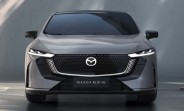Farewell to Mazda's only EV as the MX-30 rides off into the sunset
Sayonara, MX-30. Mazda's solitary electric vehicle for the American market, the MX-30, has driven off the cliff, so to speak. Not literally, mind you - no need for alarm. The MX-30 is merely checking out from the US EV market, likely to find solace in the company's cork-laden history books.
A vehicle that sold in astoundingly limited quantities (66 units this year and 324 units last year), it's fair to say the MX-30 wasn't quite the star of the American automotive scene. Then again, it was about as exclusive as a vehicle could get, considering it was only offered in California. So while Mazda may be left without an electric representative in the States, it's hard to say that the MX-30 will be missed by the masses.

Let's dissect the reason behind the MX-30's less-than-stellar performance. With a starting price of $34,110, it did not exactly break the bank. However, the EV offered a mere 100 miles of range, courtesy of its 35.5 kWh lithium-ion battery pack. Now, compare that with the Chevrolet Bolt that starts at $26,500, goes 259 miles on a single charge, and is eligible for a $7,500 tax credit. It doesn't take a genius to see which vehicle offered more bang for the buck.
Although not exactly a Goliath in terms of power, with an electric motor developing a modest 145 horsepower and 200 lb-ft of torque, the MX-30 did showcase some unique features. Its distinctive design and cork accents served as a nostalgic hat tip to Mazda's roots as a cork manufacturer. Moreover, it came pretty well-loaded with heated front seats, an 8.8-inch infotainment system, a glass roof, and Mazda Radar Cruise Control with Stop and Go.

The disappearance of the MX-30 from the American market doesn't mean Mazda is packing up its electrification ambitions, though. The automaker is simply shifting gears towards the hybrid market, with its focus trained on the CX-50 Hybrid, CX-90 PHEV, and the soon-to-be-released CX-70 PHEV. These models promise to offer a more compelling blend of performance and economy, better suited to the demands of American consumers. And let's not forget about the rotary-powered MX-30 e-Skyactiv R-EV - a mouthful of a name but an intriguing attempt to keep the MX-30 alive - at least in Europe for now.
Mazda's future electrification strategy also involves rolling out two "varieties of full electrics" based on existing and dedicated EV platforms. While there is no specific information on which model will take up the MX-30's mantle, industry reports suggest that Toyota might share its 930 miles of range EV technology with Mazda, potentially solving the latter's range issues.

So, if you're one of the few people whose heart still yearns for the MX-30, you might want to act fast. There are a handful of 2023 models waiting for a last-minute adoption on dealer lots. Grab your chance before they become a rare species, forever buried in the annals of automotive history.





Facebook
Twitter
Instagram
RSS
Settings
Log in I forgot my password Sign up